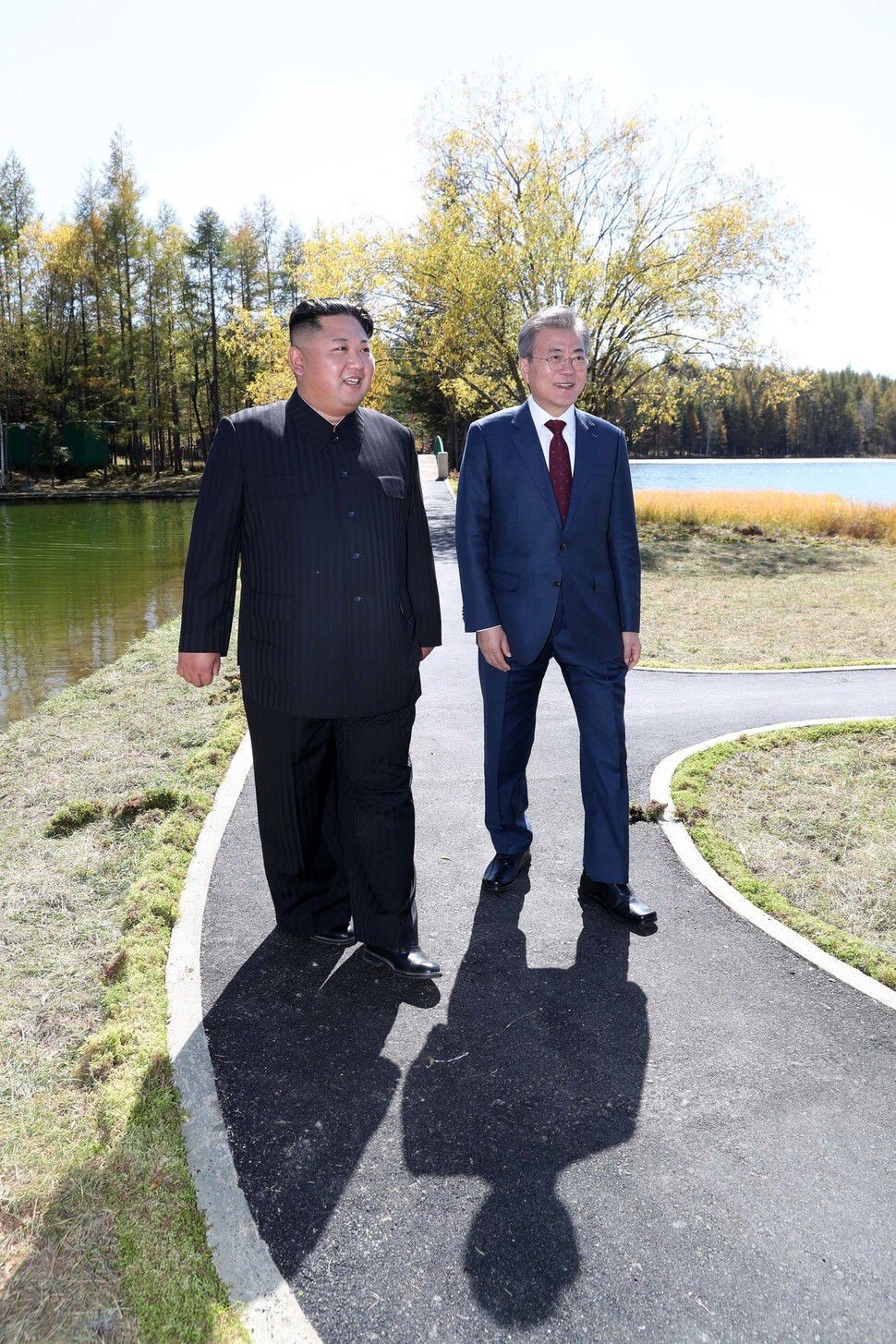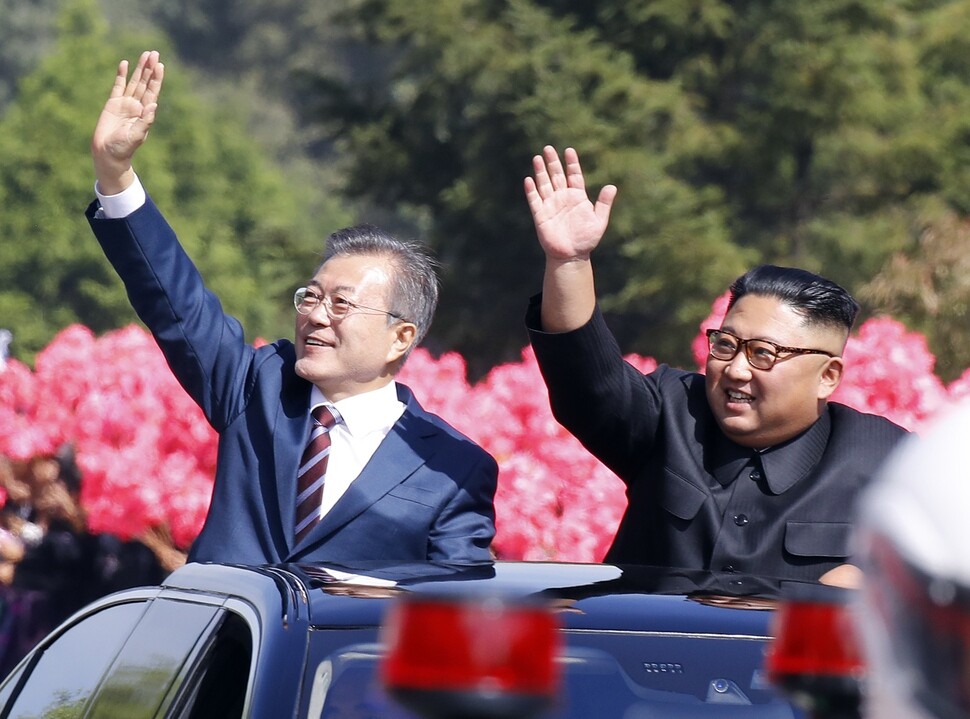hankyoreh
Links to other country sites 다른 나라 사이트 링크
Moon once again acts as “chief negotiator” between NK and US through Pyongyang summit

Through the Pyongyang inter-Korea summit with North Korean leader Kim Jong-un, South Korean President Moon Jae-in reignited the spluttering dialog between North and South Korea. The US government and President Donald Trump praised the results of the summit and announced that dialogue between North Korea and the US would also resume.
Setting the inter-Korean summit back on track, a meeting which was nearly derailed, through his surprise summit with Kim in Panmunjom in May earlier this year, and in facilitating negotiations with North Korea during the Pyongyang summit, Moon seems to be living up to Donald Trump’s request that he act as “chief negotiator.”
On Sept. 19 (local time) Trump said, of the Pyongyang Declaration of September 2018, “We had very good news from North Korea, South Korea. [. . .] We’re making tremendous progress with respect to North Korea,” and announced his intention to meeting Kim Jong-un.
US Secretary of State Mike Pompeo also expressed his intention to meet with North Korean Foreign Minister Ri Yong-ho at the UN General Assembly in New York, as well as to open a practical dialogue between North Korea and the US in Vienna, Austria.
NK-US negotiations to be held in New York and Vienna soon
In Article Five of the Pyongyang Declaration, Moon and Kim stated that “the Korean Peninsula must be turned into a land of peace free from nuclear weapons and nuclear threats, and that substantial progress toward this end must be made in a prompt manner,” and to this end, included pledges to “permanently shut down the missile engine test site and launch platform at Tongchang Village under the observation of experts from relevant countries,” as well as to take additional measures, such as the “permanent shutdown of the Yongbyon nuclear facility,” as long as the US takes “corresponding measures.”
Moon also prompted a spoken declaration from Kim to actively work towards a peaceful Korean Peninsula without nuclear weapons or the threat of nuclear weapons. This represented the first pledge on denuclearization directly from Kim. When dialogue between North Korea and the US showed signs of strain, Moon locked in the inter-Korean summit in for mid-September, although it had originally been planned only for the “fall.”

Moon’s visit to NK likely to increase momentum of resuming NK-US dialogue
In short, President Moon’s visit to North Korea had seemingly restarted the dialogue between North Korea and the US, which had been deadlocked amid disagreements over denuclearization and the termination of the war. Just ahead of his trip to North Korea, on Sept. 18, at Seoul Air Base in Seongnam, Gyeonggi Province, Moon made a statement to the effect that even if this trip to North Korea led to the resumption of dialogue between North Korea and the US, that alone would be hugely significant.
“The weighty issue of denuclearization hangs over the inter-Korea summit,” said Blue House Chief of Staff Im Jong-seok, who was the chairman of the preparatory committee for the inter-Korea summit.
“[Due to the denuclearization issue], this difficult summit will have to be approached with caution, and it is difficult to make any optimistic predictions,” Im said. This statement indicates just how much denuclearization and the arbitration of dialogue between North Korea and the US was perceived as a knotty issue.
“Mediator” Moon once again salvaged NK-US dialogueIn May earlier this year, through his surprise summit with Kim, Moon saved the North Korea-US summit from coming to a grinding halt.
In response to Trump’s sudden decision to cancel the May 24 North Korea-US summit, Moon was able to change Trump’s mind through the second inter-Korean summit, which was held only two days later. Former Minister of Unification Jeong Se-hyun, “By bringing the Pyongyang inter-Korean summit forward, President Moon was able to salvage the embers of dialogue between North Korea and the US, which were in danger of being extinguished. This is already the second time he has managed to achieve this feat. The president has become a great mediator.”
Jeong noted that Chairman Kim “is now talking about a foundation for peace, with no nuclear weapons or threats,” adding that Moon has played a “massive role” in the Pyongyang summit meeting. Although Moon was able to find a breakthrough in the denuclearization issue by serving as a mediator during the Pyongyang summit, he also came away with a number of other achievements including putting an end to 70 years of hostile relations between the two Koreas and promoting irreversible peace on the Korean Peninsula.
The military agreement signed by both Koreas stipulates that “neither side shall use force under any circumstances.” Agreement was also reached on measures to promote economic, social and cultural exchanges between the two countries. A foundation has been laid for economic cooperation in preparation for the lifting of sanctions on the North, and a permanent meeting location will be established for families separated by the Korean War.
Based on robust inter-Korean relations, the plan aims to improve North Korea-US relations in accordance with the “principle of Korean autonomy and self-determination” (main text of the September Pyongyang Joint Declaration). In a briefing held at the Seoul DDP press center on Sept. 20, Lee Do-hoon, special representative for Korean Peninsula peace and security affairs, said, “The Pyongyang Declaration demonstrates that progress in inter-Korean relations can form a foundation for improvement in North Korea-US relations.”
Moon will depart for New York on Sept. 23 to take part in the UN General Assembly, and is scheduled to meet with President Trump on Sept. 24. During this summit, Moon will explain the outcome of the Pyongyang summit to Trump and discuss issues including denuclearization of the Korean Peninsula, declaring an official end to the war at an early date, and the signing of a peace treaty.
By Seong Yeon-cheol, staff reporter
Please direct comments or questions to [english@hani.co.kr]

Editorial・opinion
![[Column] Season 2 of special prosecutor probe may be coming to Korea soon [Column] Season 2 of special prosecutor probe may be coming to Korea soon](https://flexible.img.hani.co.kr/flexible/normal/500/300/imgdb/original/2024/0426/3317141030699447.jpg) [Column] Season 2 of special prosecutor probe may be coming to Korea soon
[Column] Season 2 of special prosecutor probe may be coming to Korea soon![[Column] Park Geun-hye déjà vu in Yoon Suk-yeol [Column] Park Geun-hye déjà vu in Yoon Suk-yeol](https://flexible.img.hani.co.kr/flexible/normal/500/300/imgdb/original/2024/0424/651713945113788.jpg) [Column] Park Geun-hye déjà vu in Yoon Suk-yeol
[Column] Park Geun-hye déjà vu in Yoon Suk-yeol- [Editorial] New weight of N. Korea’s nuclear threats makes dialogue all the more urgent
- [Guest essay] The real reason Korea’s new right wants to dub Rhee a founding father
- [Column] ‘Choson’: Is it time we start referring to N. Korea in its own terms?
- [Editorial] Japan’s rewriting of history with Korea has gone too far
- [Column] The president’s questionable capacity for dialogue
- [Column] Are chaebol firms just pizza pies for families to divvy up as they please?
- [Column] Has Korea, too, crossed the Rubicon on China?
- [Correspondent’s column] In Japan’s alliance with US, echoes of its past alliances with UK
Most viewed articles
- 1Samsung subcontractor worker commits suicide from work stress
- 2‘We must say no’: Seoul defense chief on Korean, USFK involvement in hypothetical Taiwan crisis
- 3[Editorial] Korea’s surprise Q1 growth requires objective assessment, not blind fanfare
- 4Division commander ordered troops to enter raging flood waters before Marine died, survivor says
- 5Is Japan about to snatch control of Line messenger from Korea’s Naver?
- 6No good, very bad game for Korea puts it out of Olympics for first time since 1988
- 7US overtakes China as Korea’s top export market, prompting trade sanction jitters
- 8N. Korean delegation’s trip to Iran shows how Pyongyang is leveraging ties with Moscow
- 9Korea’s 1.3% growth in Q1 signals ‘textbook’ return to growth, says government
- 10[Column] Season 2 of special prosecutor probe may be coming to Korea soon